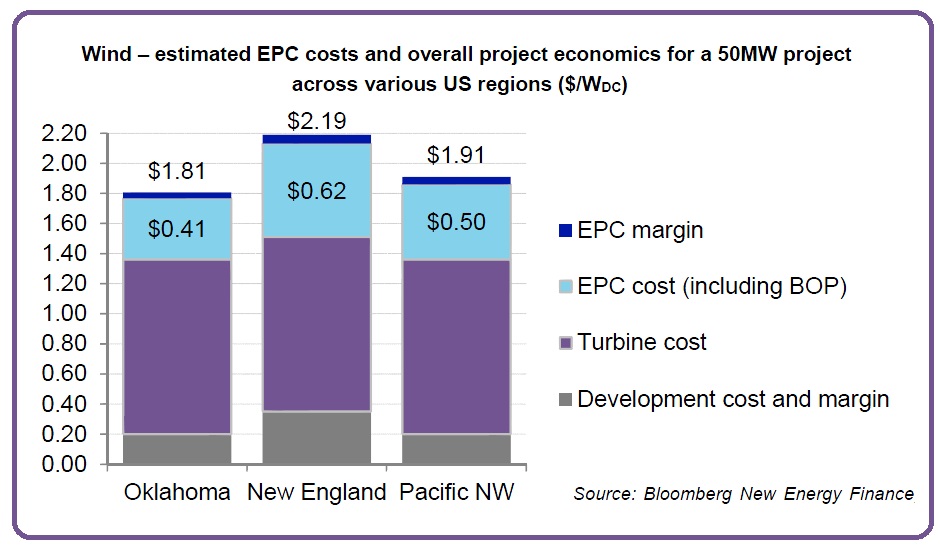This article is the executive summary from the report, The evolving landscape for engineering, procurement, and construction (EPC) firms for U.S. renewables. It is authored by tax advisory firm Cohn Reznick
Firms that provide engineering, procurement, and construction (EPC) services play a significant role in the US renewable energy industry. This report, commissioned by and with input from CohnReznick, analyzes significant themes and trends in the industry, EPC economics for solar and wind, market size projections of EPC services for these technologies, and the experience and strategies of more than 50 EPC players.
Trends and themes
- EPC costs are mostly falling – though this trend may not continue in coming years. Prices have been pushed up in oil & gas regions as competition for resources grows. In addition, rising commodity prices and poorer site conditions lead to higher costs, all else equal.

EPC price (cost plus margin) equals total project cost minus development costs (and margins) and turbine costs. Prices are representative of a 50MW wind plant with a 1-
mile gen-tie. Total capex numbers are partially based on our analysis of data from the Treasury cash grant program (more on this below). Wind turbine costs come from our H2 2014 Wind Turbine Price Index. We assume EPC margins are 10% of EPC costs. Source: Interviews with selected market participants; NREL, March 2013,
2011 Cost of Wind Energy Review.
Margins are tightening, at 5 to 8% for both solar and wind (though some firms will work for less). Wind margins may rise in 2015, when EPCs will be in high demand to get projects completed.
- Most developers are hungry for EPCs to assume as much risk as possible. But some experienced developers are willing to eschew ‘full wraps’ as a way of keeping down costs.
- Some EPCs that were general contractors with conventional energy experience have become specialists with deep expertise on renewables. Additionally, for some EPCs, the role has expanded beyond pure EPC work and into areas such as development support.
- EPCs may provide financing, but rates are usually not competitive with banks. A variation on outright financing is alternative payment structures (eg, delayed payments to the EPC).
- Some EPCs that have historically feasted on wind have now also turned to solar. Some have expressed interest in diversifying into other regions or into new technologies, like storage.
- Policy is a source of anxiety (eg, tariffs on Chinese goods, uncertainty around tax credits).
- Scarcity of engineering talent is a long-term worry.
Economics and market size
- Estimated EPC prices (including component costs but excluding development costs) for solar PV projects range from $1.38/MW for very large desert-based thin-film projects to $1.97/MW for 1 to 5 MW projects in New Jersey. Labor is the most important variable cost.
- Estimated EPC costs (including BOP, excluding turbines) for wind range from $0.41/MW in Oklahoma to $0.62/MW in New England. We used two approaches for this analysis: market interviews and examination of cost data from the now-expired 1603 Treasury grant program.
- The market size for EPC services for utility-scale PV will peak at $3.3 billion in 2016 but will fall well below this level thereafter. For wind, it will be $4.8bn in 2015, and around $2 billion annually through the rest of the decade. EPC for small-scale PV will fare better, at $6.3 billion by 2016.
Players
- We examined the project-by-project track record of 56 firms in US renewable energy EPC. The top firms in terms of ‘active’ capacity are SunPower, First Solar, Mortenson, and E Light Wind and Solar (for solar) and Mortenson, IEA, RES Americas, and Blattner (for wind).
Sources of differentiation for EPCs include: size (and bonding capacity), breadth of services, project size, and geographic focus. They also have varying strengths (track record, corporate credibility, client service) and varying approaches to business development (partnerships, in-house channels). We elaborate on each and map players to these differentiation areas.
Cohn Reznick
www.cohnreznick.com
Filed Under: Construction, News




